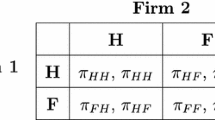Abstract
Does international tax competition in the environmental field lead to undesirably low levels of environmental regulation and to unacceptable disruptions of environmental quality? The paper tries to answer this question in a noncompetitive partial-equilibrium framework. There is one firm that wishes to establish a plant in one ofn countries. The paper shows that tax competition may lead to emission taxes that are either too low or too high. They may be so high that the investment is not undertaken, although this would be optimal if the countries cooperated. On the other end of the spectrum, a scenario in which taxes are driven to zero becomes possible if there are substantial transfrontier pollution effects.
Similar content being viewed by others
References
Barnett, A.H. (1980). “The Pigouvian Tax Rule Under Monopoly.”American Economic Review 70, 1037–1041.
Barrett, S. (1994). “Strategic Environmental Policy and International Trade.”Journal of Public Economics 54, 325–338.
Bartik, T.J. (1988). “The Effects of Environmental Regulation on Business Location in the United States.”Growth and Change 19, 22–44.
Brander, J.A., and P.R. Krugman. (1983). “A Reciprocal Dumping Model of International Trade.”Journal of International Economics 15, 313–321.
Conrad, K. (1993). “Taxes and Subsidies for Pollution-Intensive Industries.”Journal of Environmental Economics and Management 25, 121–135.
Fudenberg, D., and J. Tirole. (1991).Game Theory. Cambridge, MA: MIT Press.
Hettige, H., R.E.B. Lucas, and D. Wheeler. (1992). “The Toxic Intensity of Industrial Production: Global Patterns, Trends, and Trade Policy.”American Economic Review (Papers and Proceedings) 82, 478–481.
Hoel, M. (1994).Environmental Policy as a Game Between Governments When Plant Locations Are Endogenous. Mimeo, University of Oslo.
Jasay, A.E. (1960). “The Social Choice between Home and Overseas Investments.”Economic Journal 70, 105–113.
Kemp, M.C. (1964).The Pure Theory of International Trade. Englewood Cliffs, NJ: Prentice-Hall.
Leonard, H.J. (1988).Pollution and the Struggle for the World Product: Multinational Corporations, Environment and International Comparative Advantage. Cambridge, Cambridge University Press.
Long, N.V., and H. Siebert. (1991). “Institutional Competition Versus Ex-ante Harmonization: The Case of Environmental Policy.”Journal of Institutional and Theoretical Economics 147, 296–311.
Low, P., and A. Yeats. (1992). “Do Dirty Industries Migrate?” In P. Low (ed.),International Trade and the Environment. Washington, DC: World Bank Discussion Paper No. 159.
Lucas, R.E.B., D. Wheeler, and H. Hettige. (1992). “Economic Development, Environmental Regulation, and the International Migration of Toxic Industrial Pollution: 1960–1988.” In P. Low (ed.),International Trade and the Environment. Washington, DC: World Bank Discussion Paper No. 159.
MacDougall, G.D.A. (1960). “The Benefits and Costs of Investment from Abroad. A Theoretical Approach.”Economic Record 36, 13–35.
Markusen, J.R., E.R. Morey, and N. Olewiler. (1995). “Competition in Regional Environmental Policies When Plant Locations Are Endogenous.”Journal of Public Economics 56, 55–77.
Markusen, J.R., E.R. Morey, and N. Olewiler. (1993). “Environmental Policy When Market Structure and Plant Locations Are Endogenous.”Journal of Environmental Economics and Management 24, 68–86.
Mintz, J., and H. Tulkens. (1986). “Commodity Tax Competition Between Member States of a Federation: Equilibrium and Efficiency.”Journal of Public Economics 29, 133–172.
Motta, M., and J.-F. Thisse. (1994).Does Environmental Dumping Lead to Delocation? Milan: Fondazione ENI Enrico Mattei Discussion Paper No. 9415.
Oates, W.E., and R.M. Schwab. (1988). “Economic Competition Among Jurisdictions: Efficiency Enhancing or Distortion Inducing?”Journal of Public Economics 35, 333–354.
Rauscher, M. (1995). “Environmental Policy and International Capital Movements.” (Forthcoming) K.-G. Mäler,International Environmental Problems: An Economic Perspective. Amsterdam: Kluwer.
Repetto, R. (1992).Green Fees: How a Tax Shift Can Work for the Environment and the Economy. Washington, DC: World Resources Institute.
Rowland, C.K., and R. Feiock. (1991). “Environmental Regulation and Economic Development: The Movement of Chemical Production among States.” In M.J. Dubnick and A.R. Gitelson (eds.),Public Policy and Economic Institutions. Greenwich, CT: JAI Press.
Ulph, A. (1994). “Environmental Policy, Plant Location and Government Protection.” In C. Carraro (ed.),Trade, Innovation, Environment. Rotterdam: Kluwer.
Walter, I. (1982). “Environmentally Induced Industrial Relocation to Developing Countries. In S.J. Rubin and T.R. Graham (eds.),Environment and Trade: The Relation of International Trade and Environmental Policy. Totowa, NJ: Allanheld and Osmun.
Wildasin, D.E. (1988). “Nash Equilibrium in Models of Fiscal Competition.”Journal of Public Economics 35, 229–240.
Wilson, J.D. (1987). “Trade, Capital Mobility, and Tax Competition.”Journal of Political Economy 95, 835–856.
Zodrow, G.R., and P.M. Mieszkowski. (1986). “Pigou, Tiebout, Property Taxation, and the Underprovision of Public Goods.”Journal of Urban Economics 19, 356–370.
Author information
Authors and Affiliations
Rights and permissions
About this article
Cite this article
Rauscher, M. Environmental regulation and the location of polluting industries. Int Tax Public Finan 2, 229–244 (1995). https://doi.org/10.1007/BF00877499
Issue Date:
DOI: https://doi.org/10.1007/BF00877499




